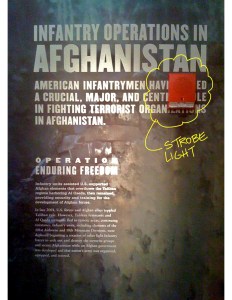
It’s not a matter of if, but when. Whether an exhibition is 500 square feet with a few labels and a curator’s catalogue, or a whopping 50,000 square feet with hundreds of graphic panels and artifacts, at some point during the design and fabrication, a mistake is going to be made.

A number of years ago I was part of the exhibit design team for a large national military museum. The exhibit contained thousands of individual graphic panels, and the label copy for each of them was reviewed and approved by members of both the designer’s and museum’s team: at least three sets of eyes on every item. But somehow, despite all quality control procedures, the term “gorilla warfare,” rather than “guerrilla warfare,” made it through design, production, and final installation before anyone noticed. A visitor spotted it a few weeks after opening. It happens!
During exhibition project kickoff meetings, I often convey to the group that at some point during the process, there will be an error. It might be a typo or inaccuracy on a label. An artifact might not fit into a case because either it or the case will be measured incorrectly. An emergency strobe light might be installed right in the middle of an important graphic. During installation, a worker might accidentally damage a mural or wall surface. The list of potential “uh-oh”s is long. It’s good to bring this up at the beginning of a project so that there are no surprises, and so that the team can sharpen their wits.
When a mistake does occur during an exhibition project, here are a few tips for keeping your head, being transparent, and getting the issue resolved.
- Acknowledge the Error – Without hesitating, recognize that an error was made. Don’t put it off, don’t gloss over it, and don’t try to hide it. If the mistake was made as part of a group process, acknowledge your role in it, and avoid pointing fingers. Blaming others or being defensive won’t resolve the issue.
- Stay in the Present – When dealing with an exhibition snafu, I once had a client sternly say, “Stop telling me what happened, and tell me what you’re going to do.” She was right. There’s no point belaboring how a mistake was made, and there will be time later to figure out how it won’t happen again. To resolve the problem, be in the now.
- Fix It! – This, of course, is key! Everyone on the project team should be solution-focused. If a solution brings its own challenges, such as added costs or a change in the project schedule, it may be necessary to accept those downsides in order to correct the mistake.
- Alter Your Process – After the issue is resolved, and if there are no other pressing items, discuss ways to improve – or implement! – your Quality Assurance plan. Paul Schoemaker, author of the book, Brilliant Mistakes, suggests that errors can often give birth to new ideas and processes, but that “this can only happen if leaders create sufficient space for productive mistakes to occur.”
However, not all mistakes are created equal. In the grand scheme of things, typos and factual inaccuracies on graphic labels are fairly benign. In rare cases, there’s a whole other tier of fearful mistakes where additional attention and steps must be taken. Errors that are extremely expensive, cause great damage or might be potentially dangerous for visitors or staff fall into this category. Examples might include an entire gallery painted the wrong color, and that has to be repainted; a pipe pierced and burst while trying to mount something to a wall, or a precious artifact dropped and broken during installation. I’ve seen these things happen. In these types of instances, consider the following:
- Review the Contract(s) – If there are two or more parties involved, where there are formal written agreements, read them over to see if there’s any clarity about exactly who is responsible for what. The contract might also stipulate how disputes are handled, such as through arbitration.
- Ask Your Insurer – Design firms and fabrication specialists often carry Errors and Omissions (E & O) and liability insurance. Museums and other institutions will carry other types of protection. In unique situations, the severity of an exhibition error may require contacting an insurer.
- Speak with Counsel – If the contract is unclear – or nonexistent – or if there’s any uncertainty at all about the appropriate steps for resolution of whatever the error, it may be time to call in the legal experts. A museum might have in-house counsel, and a private firm will probably have a relationship with a lawyer. Consult their advice on how to proceed.
To err is human. And because exhibition projects often involve many steps, numerous people, and hundreds of objects and graphics, they’re ripe for accidental missteps and oversights. However, few errors in exhibition projects are ever life-threatening or prohibitively expensive. In the more common scenarios of typos or inaccuracies on graphic panels, undersized artifact cases, and exhibit elements that won’t fit through doors, embrace the cliché about learning from your mistakes. Or as James Joyce more eloquently said, “mistakes are our portals of discovery.”









Comments